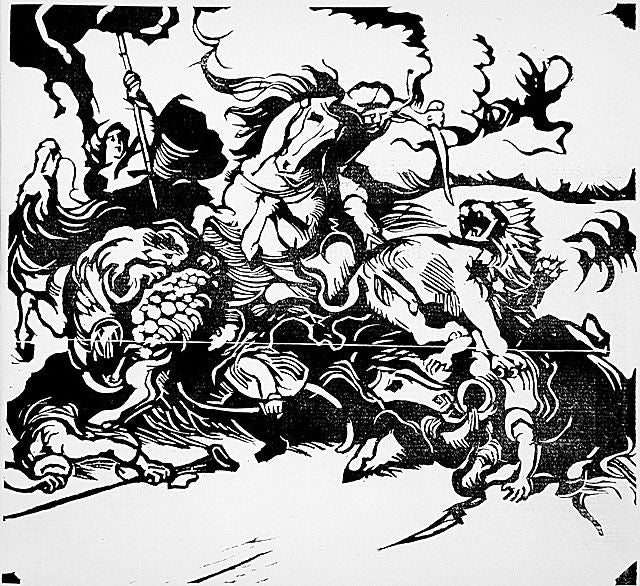Description
Franz Marc, one of the most prominent figures of German expressionism, achieved a significant milestone in his career with the work "Hunting of the Lion (after Delacroix)" of 1913. This painting, as its title indicates, is an interpretation of the famous painting by Eugène Delacroix, "the hunt for lions". However, Marc transcends the simple repetition of the work of his predecessor, contributing a vibrant palette and a compositional dynamism that underlines his own artistic and philosophical vision.
When observing the work, the first thing that is obvious is the bold choice of color. Marc uses pure and saturated tones that seem to vibrate on the surface of the canvas, in a clear alignment with the postulates of expressionism. The palette is dominated by intense red and deep blue, which not only capture the energy of hunting, but also evoke an almost visceral sense of nature. Through its use of color, Marc transmits deep emotions, suggesting that hunting violence is an intrinsic part of human and animal experience.
The composition is characterized by a palpable dynamism: the contours of the figures, which represent lions and hunters, are delineated with a strong and energetic line. This technique not only highlights the elements in the foreground, but also achieves a sensation of movement and primitive strength. The viewer's gaze is guided by curved and angular forms, creating a visual route that advances from the hunter to its prey, formulating a dialogue between the predator and the victim.
The figures portrayed in the work, although they are not the most detailed representations, are impregnated with an expressiveness that reveals both the tension of the moment and the symbolism of the struggle between the wild essence of nature and human intervention. Marc invites us to contemplate hunting not only as a physical act, but as a metaphor for the struggle for life, a recurring theme in his work, which advocates the union of the human being with the animal world.
It is interesting to note that this work, conceived in a pre -belic context, refers to a deep philosophical search that Marc explored throughout his career. Through his canvases, the artist holds a conversation about the spirituality inherent in all living beings, reiterating his commitment to the idea that nature is an entity that must be venerated and understood in its entirety. In this sense, "Lion Hunting" stands as a testimony of Marc's thought, at a time where chaos began to glimpse himself on the horizon of Europe.
Delacroix's influence is undeniable, but Franz Marc, by reinterpreting this theme, introduces his own symbology and aesthetics. That reference to a master of romanticism is harmonized with the vision of the artist of the twentieth century, creating a bridge between two times and styles. The work is not only celebrated by its technique and aesthetics, but also by its ability to evoke a deep reflection on the role of the human being in the cycle of life.
In conclusion, "Lion Hunting (after Delacroix)" is a work that, through its vibrant color and its dynamic composition, encapsulates the essence of Franz's philosophy. Marc. He urges us to explore the complex link between the Human and nature, presenting hunting as a search for meaning in a world that often seems chaotic and violent. This piece reminds us that art has the power to transform the perception of life itself, suggesting that, through aggression, beauty can also be found.
KUADROS ©, a famous paint on your wall.
Hand-made oil painting reproductions, with the quality of professional artists and the distinctive seal of KUADROS ©.
Art reproduction service with satisfaction guarantee. If you are not completely satisfied with the replica of your painting, we refund your money 100%.

